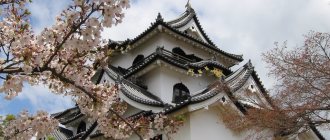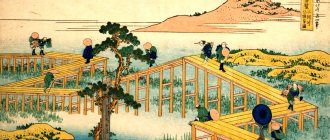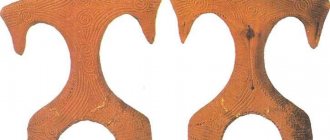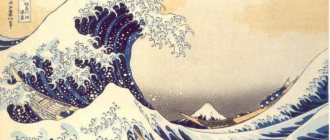“Future Technological Heritage” is an informal name for “Important Scientific Technology Materials,” which are selected by studying industrial technologies of significant historical significance. The collection of such materials is carried out by the National Museum of Nature and Science, which thus seeks to preserve the heritage of Japanese technology for the future. Great importance is attached not only to the importance of objects for the history of the development of scientific technology, but also to the influence that they had on everyday life, society and culture.
The National Museum of Nature and Science's selection center for materials on the history of manufacturing technology conducts two types of research:
1) Comprehensively examines materials on the history of production technologies;
2) Having identified a narrow area of technology, veteran engineers who have been involved in actual developments in specific technological areas conduct a final genealogy study in the history of technology development.
After this, the studied objects are discussed at meetings of the Center’s commission and a commission of invited experts, after which they are included in the list of “Technological Heritage of the Future.” You can read about the research on the website of the National Museum of Nature and Science.
There are now 225 objects on the list of "Technological Heritage of the Future", and we will present several that reflect the characteristics of Japanese industrial technology.
The world's first Japanese technological innovations
No. 00210 Yagi-Uda Antenna
The first high performance VHF antenna. It was developed by Yagi Hidetsugu and Uda Shintaro, who were conducting magnetron research at Tohoku University in the 1920s. At that time, long, medium and short waves were used for communication, and after them, VHF and decimeter wave technologies were developed. Abroad, earlier than in Japan, they appreciated the capabilities of the antenna, and during the Second World War they were used by Allied troops. Nowadays, both in Japan and throughout the world, television antennas of this type are used very widely (photo courtesy of the National Museum of Nature and Science)
No. 00150 Lamp for color photography of the stomach wall
The world's first electric lamp designed for color photography of the walls of the stomach. Created in 1954. At that time, color photographic films had low sensitivity and required good lighting, and powerful lamps generated a lot of heat and had a negative effect on the walls of the stomach. To avoid this, the lamp was made multilayer, and two lamps of different power were installed in a cylindrical body. During production, we took care of the color temperature in order to obtain high-quality photographs, and to ensure that the lamp did not burn out during use. Endoscopes began to be used for medical examinations when it became possible to obtain high-quality color photographs of the stomach (photo courtesy of the National Museum of Nature and Science)
No. 00121 CASIO SL-800 calculator
The thinnest calculator in the world. With a thickness of 0.8 mm, it remains the thinnest yet, and embodies the idea of miniaturization brought to perfection. Such a calculator is kept in the New York Museum of Modern Art. This minimum thickness is achieved through the use of integrated circuits with a thickness of 0.5 mm, a liquid crystal display of 0.55 mm, solar cells of 0.2 mm and other components mounted on a flexible plate. When the calculators went on sale in 1983, they cost 5,900 yen (photo courtesy of the National Museum of Nature and Science)
Rangaku
However, European science still penetrated into Japan. The Dutch trading post, located on the small island of Dejima in Nagasaki harbor, became the source of information known as rangaku (“Dutch sciences” in Japanese). The Japanese authorities, having once been burned by Christianity, at first considered this knowledge dangerous. The translation of Dutch books was strictly monopolized and carried out by a narrow circle of specially trained translators who rewrote Western knowledge into the Japanese style. The main areas of study included geography, medicine, natural sciences, astronomy, art, foreign languages, the study of electrical phenomena and mechanics. Thanks to the knowledge gained, wadokei, striking clocks, were created in the 18th century, one of the first Japanese inventions in the field of technology. The weakening of isolationist policies at the beginning of the 18th century, as well as the literacy of the majority of the Japanese, contributed to the widespread dissemination and popularization of European scientific knowledge. At the same time, foreign innovations appeared in the state - telescopes, microscopes, pumps, mechanical watches and other advanced inventions. Of greatest interest to the Japanese was the experience of Europe in the field of medicine, as well as electricity, which was being actively developed by Western scientists. It was rangaku that gave Japan the opportunity to quickly make up for lost time and very quickly reach the same level as Europe in the field of scientific knowledge.
Technologies that changed Japanese society
No. 00118 Robot FANUC ROBOT MODEL 1
It is a multifunctional robot that has been widely used due to its low cost. Created in 1977. The position control robot has five degrees of freedom, uses a cylindrical coordinate system, DC servomotors and pneumatic control cylinders. Their use subsequently led to significant increases in productivity in Japan, which is now known as a country with automated manufacturing. (Photo courtesy of FANUC)
No. 00185 Entertainment robot AIBO ERS-110
AIBO ERS-110 is the first model of the world's first commercially produced and sold autonomous robot for home use and living with people. Created in 1999. He can imitate emotions and communicate with people, learn actions and “grow up.” Such robots are no longer produced, but they still interact with people, as shown, for example, by holding funeral services for robot dogs in 2021. (photo courtesy of SONY)
No. 00045 1st car of the high-speed passenger train Shinkansen series 0 of the Tokaido Shinkansen line
The first model of the Shinkansen train to go into mass production, which has become synonymous with high-speed rail service. For the Tokaido Shinkansen line, launched on October 1, 1964, special technologies were developed; it did not intersect with existing tracks, had a different gauge with a width of 1435 mm, a centralized traffic control system, a system for protecting and inspecting the condition of the track, which ensured a high level of safety and trust with passenger side. (photo courtesy of the National Museum of Nature and Science)
Wearable robot / PowerloaderLightPLL-0
What could be better for people with mobility problems than a robot that can allow them to walk, run, work? Japanese company Panasonic is currently developing significant improvements in exoskeleton robotics that people wear like a suit. What was previously used only for military purposes will soon be available to workers, the disabled, or anyone who for some reason lacks the strength to carry out everyday activities. The Powerloader suit costs about $7,000, weighs 40 kilograms and can carry a load of up to 30 kilograms. If the suit is eventually made lighter, smaller and stronger, the Powerloader could revolutionize the way people work and recover from injury.
READ ALSO: 15 things you should never buy secondhand
Japanese technologies helping humanity
No. 00072 Journal of experiments with adrenaline by Uenaki Kenzo
A journal describing experiments with adrenaline, kept by Uenaka Kenzo, who helped Takamine Jokichi when he isolated this hormone for the first time in the world. In the controversy that erupted after Takamine's death, in American medicine it was persistently called "epinephrine", this name spread among Japanese doctors, but in the end Takamine's primacy was proven, and the name "adrenaline" began to be widely used. (photo courtesy of the National Museum of Nature and Science)
No. 00209 Journal of experiments with statins and a monthly document describing its research
Endo Akira discovered mevastatin ML-236B, the first of the statins, substances that inhibit the enzyme HMG-CoA reductase and can significantly lower cholesterol levels, helping to treat diseases in adult patients. Capsules with a substance first used for treatment in 1971, a monthly journal and notes from an assistant reflecting the progress of Endo's experiments have been preserved (photo courtesy of the National Museum of Nature and Science)
No. 00135 Anti-mosquito coil
Invented in Japan in 1890, the mosquito coil helped fight malaria and other mosquito-borne diseases and is still widely used around the world. Pyrethrum, a mosquito repellent, was distributed in Japan by Ueyama Eiichiro, and at one time its production volumes were the largest in the world. (Photo courtesy of Dainihon jochugiku)
No. 00109 The first stereo cassette audio player Walkman TPS-L2
The world's first stereo player with headphones. It went on sale in 1979 and radically changed the way people listen to music around the world. Walkman cassette players were produced until 2009, with a total of 220 million units produced. With the development of digital technologies, media and form have changed, but all over the world they are creating and happily using devices that inherited its concept. (photo courtesy of SONY)
TOP 25: The most incredible Japanese inventions in history
Throughout history, the Japanese have created some of the most important inventions for human civilization. From weapons to electronics, their inventions have permeated our culture, entertainment, and everyday life. The Japanese became pioneers in the technology sector, creating devices that we take for granted today. It's safe to say that the world would be a completely different place without them. Curious to know what Japan's contribution to society is? Here are 25 of the most incredible Japanese inventions of all time. 25. Rickshaw
Photo: commons.wikimedia.org
Have you seen those carts pulled by people that carry other people? This clever and simple invention is called a rickshaw and was first invented by the Japanese in 1860. At that time it was an inexpensive and popular form of transport. It's also a great way to stay in shape.
24. Instant noodles
Photo: commons.wikimedia.org
Do you like instant noodles? Then you can thank the Japanese for this amazing invention. Noodles were invented by Momofuku Ando while looking at the devastation caused by World War II. Chikin Ramen instant noodles first hit shelves in 1958, and college dorms were never the same again.
23. Roman
Photo: WikipediaCommons.com
The Tale of Genji, written in 11th century Japan, is considered the first novel ever written. It was written by a woman named Murasaki Shikibu, and it was the story of a handsome aristocrat and his many affairs.
22. Katana
Photo: commons.wikimedia.org
Although it is believed that an earlier version of the katana sword came to Japan from China, the katana we know today, lighter and skillfully crafted by the Japanese, was used by samurai warriors. It first appeared during the Muromachi period from 1392-1573. n. e.
21. Imari porcelain
Photo: WikipediaCommons.com
Invented in Japan in the 16th century, Imari porcelain was a popular product exported by the Dutch East India Trading Company. This material was discovered and produced from porcelain by master Ri Sampei.
20. Microcomputer
Photo: WikipediaCommons.com
The first microcomputer was the Sord SMP80/08, invented and developed in 1972. Although it was a failure and never went on sale, it was a great leap forward in the computer field.
19. Player
Photo: commons.wikimedia.org
While the technology itself had been around for some time, Sony offered to put cassette tapes in a compact box, allowing you to listen to music on the go. They called their invention Walkman, and the player appeared on the market in 1979. For the first time in history, this invention helped cassettes surpass vinyl records in terms of sales.
18. Lean production
Photo: commons.wikimedia.org
Developed by Toyota in Japan after World War II, the lean manufacturing system, or Just In Time system, emerged from studies of the Ford production system but was adjusted to suit Japanese needs. The goal of the system was to reduce waste while maintaining productivity. This is a fairly common concept now.
17. CDs, DVDs, and Blu-Rays
Photo: commons.wikimedia.org
Compact discs were invented simultaneously by Sony and Philips (a Dutch company). The companies discussed finer details, but ultimately agreed on the drive we have today, 115mm in diameter and capable of holding 74 minutes of data. Later, Sony would continue to develop both DVD and wage war against HD-DVD with its excellent Blu-Ray discs.
16. Programmable musical drum machine
Photo: commons.wikimedia.org
Invented by Ikutaro Kakehashi, the Roland TR-808 was the first programmable drum machine. When it hit the market in 1980, it revolutionized music and was especially popular for its bass drum.
15. Karaoke
Photo: Pixabay.com
The karaoke machine was invented by Daisuke Inoue in 1969, but it did not hit the market until 1971. At first, karaoke did not cause much excitement, after a while all the bars in Japan dreamed of getting it. But although Daisuke was the inventor, he never invented the term "karaoke". This name comes from the phrase "Kara okesutura", which means "empty orchestra". The name was shortened to “karaoke” and it stuck.
14. Emoji
Photo: pixabay
You should thank the Japanese for the emoticons on your phone. Emoji were created by Shigetaka Kurita and his team at NTT DoCoMo when he became frustrated with the reliance on text alone to convey information. As a solution, imagery was developed to represent emotions.
13. Video camera
Photo: commons.wikimedia.org
While portable video recording devices have been around since the 50s, Sony released the very first camcorder in 1983. She wrote everything on Betamax tape and made recording films much easier than before.
12. Electric rice cooker
Photo: commons.wikimedia.org
The first electric rice cookers were invented by Toshiba in 1955. By 1960, the device had revolutionized households, and by 1970, rice cookers continued to improve with microcomputers that could regulate temperature.
11. Phone with camera
Photo: commons.wikimedia.org
Today, a camera on a mobile phone is commonplace, but back in 1999, it was unheard of. The Japanese company Kyocera Corporation released the first mobile phone with a camera. They called it the VisualPhone VP-210, and it could store up to 20 JPEG images. 10. Portable ECG machine
Photo: Pixabay.com
For those with heart problems, thanks to the Japanese, carrying an ECG machine with them has become much easier. In 1937, Taro Takemi invented the first portable electrocardiogram measuring device. Many of its basic principles are still used today.
9. Pocket calculator
Photo: commons.wikimedia.org
Calculators have been around for a very long time, but the first microchip-based pocket calculator was invented by the Japanese company Busicom in 1970. It was called Busicom LE-120 Handy.
8. Blue LED lighting
Photo: commons.wikimedia.org
Three Japanese inventors, Isamu Akasaki, Hiroshi Amano and Shuji Nakamura, invented the first blue LED in the 1990s, leading to the development of all the LED products we have today. They later received the Nobel Prize for this invention.
7. Lithium battery
Photo: commons.wikimedia.org
In Japan, Asahi Kasei did significant work on rechargeable lithium-ion battery technology, modifying previous research on the topic, and Sony Corporation allowed the technology to enter the consumer market.
6. QR code
Photo: MaxPixel.com
While today you can use a QR code to get information about a company or product, it was originally invented in 1994 by a Toyota subsidiary called Denso Wave to help in the manufacturing process.
5. CRISPR
Photo: commons.wikimedia.org
Although no one actually “invented” the CRISPR sequence, a powerful gene-editing technique, it was discovered in 1987 by Yoshizumi Ishino and his team at Osaka University. Unfortunately, at the time they didn't really understand what they had discovered. However, their research laid the foundation for what was to come.
4. 3-D printers
Photo: commons.wikimedia.org
3D printing may seem like a new phenomenon, but the technology has been around for some time. In 1981, at the Nagoya Municipal Industrial Research Institute, Hideo Kodama published his idea for a rapid prototyping system using photopolymers. This was the first 3D printer concept.
3. High speed train
Photo: Pixabay.com
In the USA, after the invention of the automobile, trains lost popularity. However, in Japan they returned to the “high road”. in 1964, Japan invented and introduced the first high-speed rail line, or bullet train, from Tokyo to Osaka. This invention gained worldwide popularity, especially in densely populated areas in need of fast mass transport.
2. Flash memory
Photo: maxpixel
Flash memory allows you to store data such as music, photos and videos in your mobile phone and smartphone. Without it, you can say goodbye to your phone. Fujio Masuoka, then at Toshiba, invented flash memory in 1984 to solve the problem of remembering and storing data regardless of whether the device is turned on or off.
1. Android robots
Photo: commons.wikimedia.org
Developed at Waseda University in Japan, the world's first android robot was called WABOT-1. He was made in 1970, he had artificial ears, a mouth, and eyes, and he could pick up objects.
Institute of Oriental Studies of the Russian Academy of Sciences
The Center for Japanese Studies is one of the basic scientific divisions of the Institute of Oriental Studies, operating within the framework of the program “East-Russia: cultural-historical and socio-political relationships”, defined by the historical and philological department of the Russian Academy of Sciences.
The main task of the Center for Japanese Studies is a multidimensional comprehensive study of the state and society of modern Japan, the main political, economic, social and cultural processes occurring in the country, as well as the role of Japan in the international arena, including interstate relations and security problems. At the same time, a large place in the work of the Center is traditionally given to a deep knowledge of the history of the country, ancient religion, the centuries-old cultural and spiritual heritage of the Japanese people, national traditions, without which it is impossible to correctly understand modern phenomena, starting with Japanese popular culture all over the world and ending with the problems of scientific progress, the study of which is also within the scope of scientific interests of the Center’s staff. The study of the unique and original experience of modernization of Japan, which determined the rapid transformation of the country into one of the world leading countries, still does not lose its relevance.
This wide range of Japanese studies topics is devoted to both the individual scientific works of the Center’s employees, their articles in leading scientific and popular journals, and collective monographs published annually by its team with the involvement of colleagues from the leading scientific and educational centers of our country. One of the latest examples of such collaboration is the book “The Japanese Phenomenon. Views of Russian Japanese scholars" (2018). And the unique calling card of the Center has become the popular science publication “Japan. Yearbook”, well known not only to specialists, but also to a wide audience of readers interested in Japanese issues. A number of Center employees successfully combine their research and journalistic activities with teaching the Japanese language and Japanese studies at leading universities in Moscow.
The Center has established good working contacts with a number of Russian government, scientific and public structures, such as: the Russian Association of Japanese Studies, the Russian Council on International Affairs, the National Committee of the Asia-Pacific Security Cooperation Council, etc. For many years, extensive scientific contacts have been carried out with universities and Japanese studies centers in our country and other countries. For about 40 years, scientific exchanges have been maintained with one of the largest Japanese universities, Hosei. The practice of scientific cooperation with representatives of Japan and other countries includes bilateral and multilateral symposia and conferences on current issues in the study of Japan, joint printed publications, scientific trips, etc.
The head of the Center is Elena Leonidovna Katasonova, Candidate of Philology and Doctor of Historical Sciences.









